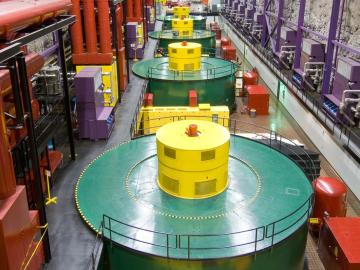Filter News
Area of Research
News Topics
- 3-D Printing/Advanced Manufacturing (6)
- Advanced Reactors (2)
- Artificial Intelligence (13)
- Bioenergy (4)
- Biology (6)
- Biomedical (3)
- Biotechnology (2)
- Buildings (5)
- Chemical Sciences (3)
- Climate Change (4)
- Composites (1)
- Computer Science (8)
- Decarbonization (9)
- Education (1)
- Emergency (1)
- Energy Storage (2)
- Environment (7)
- Exascale Computing (4)
- Fossil Energy (2)
- Frontier (5)
- Fusion (3)
- Grid (4)
- High-Performance Computing (7)
- Isotopes (5)
- Machine Learning (4)
- Materials (6)
- Materials Science (7)
- Mathematics (1)
- Microscopy (2)
- Nanotechnology (1)
- National Security (7)
- Net Zero (3)
- Neutron Science (5)
- Nuclear Energy (4)
- Partnerships (7)
- Physics (1)
- Quantum Computing (5)
- Quantum Science (9)
- Security (1)
- Simulation (7)
- Space Exploration (3)
- Summit (4)
- Sustainable Energy (8)
- Transportation (3)
Media Contacts

Researchers at the Statewide California Earthquake Center are unraveling the mysteries of earthquakes by using physics-based computational models running on high-performance computing systems at ORNL. The team’s findings will provide a better understanding of seismic hazards in the Golden State.

Scientists at ORNL and the University of Tennessee have developed an algorithm to predict electric grid stability using signals from pumped storage hydropower projects. The method provides critical situational awareness as the grid increasingly shifts to intermittent renewable power.

Scientists at ORNL are looking for a happy medium to enable the grid of the future, filling a gap between high and low voltages for power electronics technology that underpins the modern U.S. electric grid.

ORNL and the University of Tennessee, Knoxville, co-hosted the 2023 National Society of Black Physicists Annual Conference with the theme "Frontiers in Physics: From Quantum to Materials to the Cosmos.” As part of the three-day conference held near UT, attendees took a 30-mile trip to the ORNL campus for facility tours, science talks and workshops.

ORNL’s Janet Meier won the Energy Security category of the U.S. Department of Energy’s inaugural National Lab Research SLAM on Capitol Hill.

From July 15 to 26, 2024, the Department of Energy’s Oak Ridge National Laboratory will host the second U.S. Quantum Information Science, or QIS, Summer School.

Researchers at the Department of Energy’s Oak Ridge and Lawrence Berkeley National Laboratories are evolving graph neural networks to scale on the nation’s most powerful computational resources, a necessary step in tackling today’s data-centric

New computational framework speeds discovery of fungal metabolites, key to plant health and used in drug therapies and for other uses.

Technology Transfer staff from Department of Energy’s Oak Ridge National Laboratory attended the 2024 Consumer Electronics Show, or CES, in Las Vegas, Jan. 8–12.

ORNL’s successes in QIS and its forward-looking strategy were recently recognized in the form of three funding awards that will help ensure the laboratory remains a leader in advancing quantum computers and networks.




